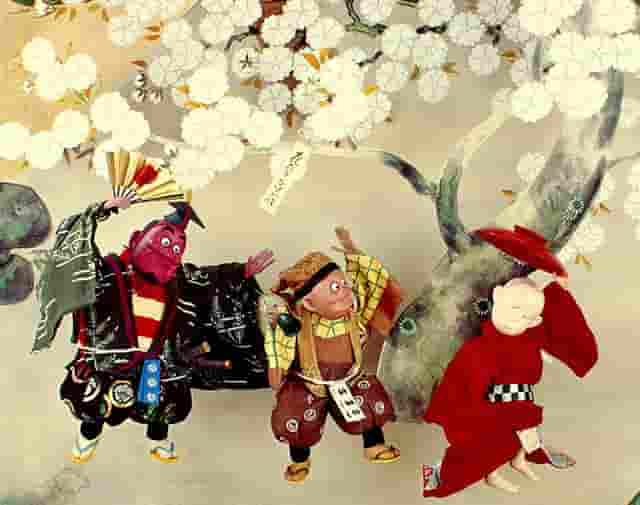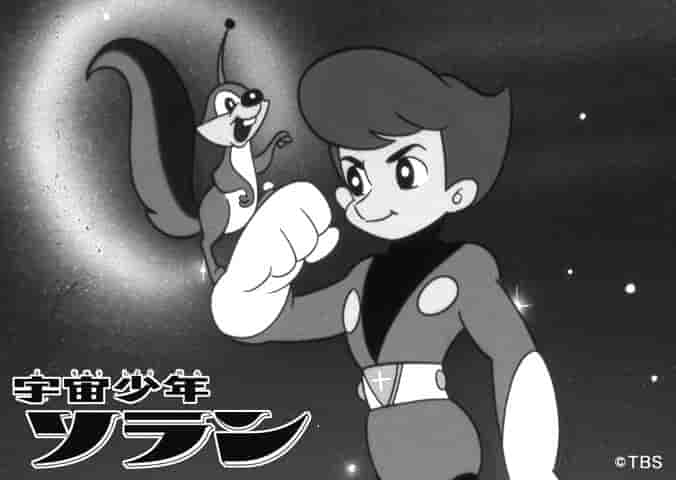Hanaori Review: A fusion of beautiful visuals and deep story

"Hanaori" - The origin of Kihachiro Kawamoto's puppet animation■ Public MediaIndependent Production ■ Original MediaAnime Original ■ Release date1968 ■Frequencies14 min ■Original Story・Original story: Mibu Kyogen "Hanaori" ■ Director・Direction: Kihachiro Kawamoto ■ ProductionAnimation: Kihachiro Kawamoto, Koichi Oikawa ■ StoryIt's springtime, and stately cherry trees with verdigris-covered trunks are in full bloom in the grounds of a certain temple. There seems to be a Buddhist event taking place elsewhere, so the old priest in his robes tells the young monk to be careful of the cherry trees and to keep people away from the temple grounds. He has him hang a sign on the branch saying "Do not enjoy the flowers" before leaving. While the young monk is busy chanting sutras, two men carrying large gourds come to the temple looking for a place to view the cherry blossoms. The young monk can't help but be curious about the two men, who smell like sake. When the rich man pours a cup to the brim, the young monk climbs up the wall, and while the rich man is looking elsewhere, he drips his rosary into the cup, soaks it in sake, and licks it all over. He then steals the cup and drinks the sake, then draws water from a stream that has been drawn into the temple grounds and pours it over the rich man's head. Enraged, the rich man grabs the young monk's arm and brandishes his sword, forcing him to open the door to the temple grounds. The young monk, who has a weakness for alcohol, drinks too much as he is encouraged to, and eventually loses his sense of self. ■ExplanationThis is Kihachiro Moto's first independent puppet animation. Its motif is that of the performing arts started by Engaku Shonin, who established Mibu-dera Temple in Kyoto, and known as "Mibu-san no Kanden-den," which has been loved by the common people. Unlike other kyogen, it is performed as a silent theater (pantomime) with gestures in order to preach Buddhist teachings in an easy-to-understand way. This "Hanaori" humorously warns against the mistakes of drunken people. Before going to Czechoslovakia, Kawamoto was invited by playwright Izawa Tadashi to see this kyogen with Kuroyanagi Tetsuko and others, and it inspired him to create the animation. It is very interesting that the idea of silent theater and a message to the common people was reborn as animation after 700 years. In 1963, at a time when overseas travel was difficult, Kawamoto visited Jiri Trnka in the Czech Republic. Trnka advised him that "Japan has stylized theatrical expressions such as Bunraku and Noh," and this monumental work was the encounter between traditional Japanese beauty and Kawamoto's puppets. With Mibu Tsuyuhiko's Momoyama-style sliding screen paintings as a backdrop, you can see the movements of the young monk and the camera's perspective as well as his profound artistic vision. Furthermore, the stream that runs through the temple grounds features a stylized representation of water from Ogata Korin's "Red and White Plum Blossoms Screen." These are not merely formal borrowings from Japanese art. The young monk climbs the wall in the bird's-eye view and draws water from the stylized stream, expanding the world of light-hearted and joyful expression. The cherry blossoms, which could be said to be another main feature of the work, are inspired by Hasegawa Kyuzou's "Cherry Blossoms" at Chishaku-in Temple. This "flower folding" is the origin of Kawamoto's art. ■Cast・Tetsuko Kuroyanagi ■ Main staff・Screenplay / Kihachiro Kawamoto・Direction / Kihachiro Kawamoto・Puppets / Kihachiro Kawamoto, Eiko Misumi, Hiroko Aoyama・Animation / Kihachiro Kawamoto, Koichi Oikawa・Music / Akihiro Komori・Title lettering / Tadashi Iizawa・Background / Tsuyuhiko Mibu, Ryo Nakagawa・Cinematography / Ken Yoshioka・Lighting / Ryuzo Nomura・Sound recording / Kazuo Ito・Sound effects / Iwao Takahashi・Editing / Fusako Morizui ■Detailed explanation and evaluation"Hanaori" is the origin of Kihachiro Kawamoto's puppet animation and is highly regarded for its artistic and technical innovation. The work is based on the Mibu Kyogen play "Hanaori" and is notable for its reproduction of traditional Japanese performing arts in the form of modern animation. In particular, by adopting the silent theater format, the emphasis is placed on visual expression, successfully conveying a direct message to the audience. Influenced by the Czech artist Jiri Trnka, Kihachiro Kawamoto decided to incorporate traditional Japanese theatrical expression into his animation. This work skillfully incorporates elements of Bunraku and Noh, achieving both visual beauty and a deep message. The results of his search for new ways of expression while respecting the traditions of Japanese art, such as Mibu Tsuyuhiko's Momoyama-style sliding screen paintings and Ogata Korin's depiction of water in the "Red and White Plum Blossoms" folding screen, are evident. The movement of the young monk and the camera's perspective demonstrate Kawamoto's profound artistic vision and provide a visual treat. The depiction of cherry blossoms is inspired by the "Cherry Blossoms" painting at Chishaku-in Temple, symbolically expressing the relationship between nature and humans. This work not only demonstrates Kawamoto's artistic and technical innovation, but also plays an important role in passing on traditional Japanese culture to the present day. ■Reasons for recommendation"Hanaori" is the origin of Kihachiro Kawamoto's puppet animation, and is a work that combines traditional Japanese culture with modern animation technology. By adopting the form of silent theater, he places emphasis on visual expression and succeeds in conveying a direct message to the audience. In addition, the story, based on the Mibu Kyogen play "Hanaori," humorously warns against the mistakes of drinkers, and is not only visually entertaining but also has a deep message. This work not only demonstrates Kawamoto's artistic and technical innovation, but also plays an important role in passing on traditional Japanese culture to the present day. Influenced by the Czech artist Jiri Trnka, Kawamoto's incorporation of traditional Japanese theatrical expression into animation is particularly noteworthy. The film shows Kawamoto's exploration of new ways of expression while respecting the traditions of Japanese art, such as Mibu Tsuyuhiko's Momoyama-style sliding screen paintings and Ogata Korin's depiction of water in the "Red and White Plum Blossoms" folding screen. The movement of the young monk and the camera's perspective demonstrate Kawamoto's profound artistic vision and provide a visual treat. The depiction of cherry blossoms is inspired by the "Cherry Blossoms" painting at Chishaku-in Temple, symbolically expressing the relationship between nature and humans. This work not only demonstrates Kawamoto's artistic and technical innovation, but also plays an important role in passing on traditional Japanese culture to the present day. ■ Related works and recommendationsAfter watching "Hanaori," be sure to check out other works by Kihachiro Kawamoto. In particular, "Doll House" and "Book of the Dead" will help you to understand the technique and artistry of Kawamoto's puppet animation more deeply. Also, if you are interested in Mibu Kyogen and traditional Japanese theater, we recommend "Bunraku" and "Noh" performances. Through these works, you will be able to gain a deeper understanding of the fusion of traditional Japanese culture and modern animation technology. ■ Summary"Hanaori" is the origin of Kawamoto Kihachiro's puppet animation, and is a fusion of traditional Japanese culture and modern animation technology. By adopting the form of silent theater, he places emphasis on visual expression and succeeds in conveying a direct message to the audience. The story, based on the Mibu Kyogen play "Hanaori," humorously warns against the mistakes of alcoholics, and is not only visually entertaining but also has a deep message. This work not only demonstrates Kawamoto's artistry and technical innovation, but also plays an important role in passing on traditional Japanese culture to the present day. We recommend that you give it a watch. |
<<: The Invisible Man: The Appeal of Invisible Presence and Its Evaluation
>>: Two Pacific Saury [Revised Edition] - Reevaluation and Recommended Points
Recommend
The appeal and evaluation of Cheese Sweet Home OVA #1: A deep look into the new developments in the series
Cheese Sweet Home OVA#1 Review and More Informati...
The anime version of the SF masterpiece "7SEEDS" will be released on June 28th! Netflix exclusively releases
The official animated version of the popular scie...
The latest animated film trailer of "Crayon Shin-chan" will be released on April 23, 2021
The official title of the latest 29th theatrical ...
The horror film "Candyman" released a new TV commercial and will be released in North America on August 27
The horror film "Candyman" released a T...
Street Fighter ZERO THE ANIMATION - A masterpiece that recreates the appeal of fighting games through animation
Street Fighter ZERO THE ANIMATION ■ Public Media ...
"The Wandering Earth" Director Guo Fan: I hope that investors and audiences will not leave the film industry
Today (May 20), the second "Golden Youth Fil...
Luxurious production lineup! The epic masterpiece "Pirates of the Caribbean" TV animation will be broadcast in 2019
The TV animation of "Pirate Chronicles"...
Fried Chicken will play a key role in Netflix's major police drama "Jigsaw"
According to the famous media Deadline, fried chi...
New set photos of The Witcher TV series leaked: a night scene with two moons
The Witcher novels are filled with beautiful, alm...
61-year-old actor Tony Leung Chiu-wai was awarded the Venice Lifetime Achievement Award
The 61-year-old Hong Kong film emperor Tony Leung...
"86: The Non-Existent Region" TV animation Chapter 2 first trailer to be aired in October
The second chapter of the TV animation "The ...
The movie "Ducks Go Forward" has been confirmed to be introduced and the release date is yet to be determined
Sina Film reported today (October 20) that Illumi...
The official trailer for the third season of "KonoSuba: God's Blessing on This Wonderful World!" has been released
The official trailer for the highly anticipated t...
A station handles the animation girl welfare picture in this way, and the novel mosaic catches netizens off guard
Mosaic is a major obstacle to the progress of hum...
"Transformers: Rise of the Power Warriors" confirmed to be introduced to mainland China, release date to be determined
Today (April 26), the movie "Transformers: R...









